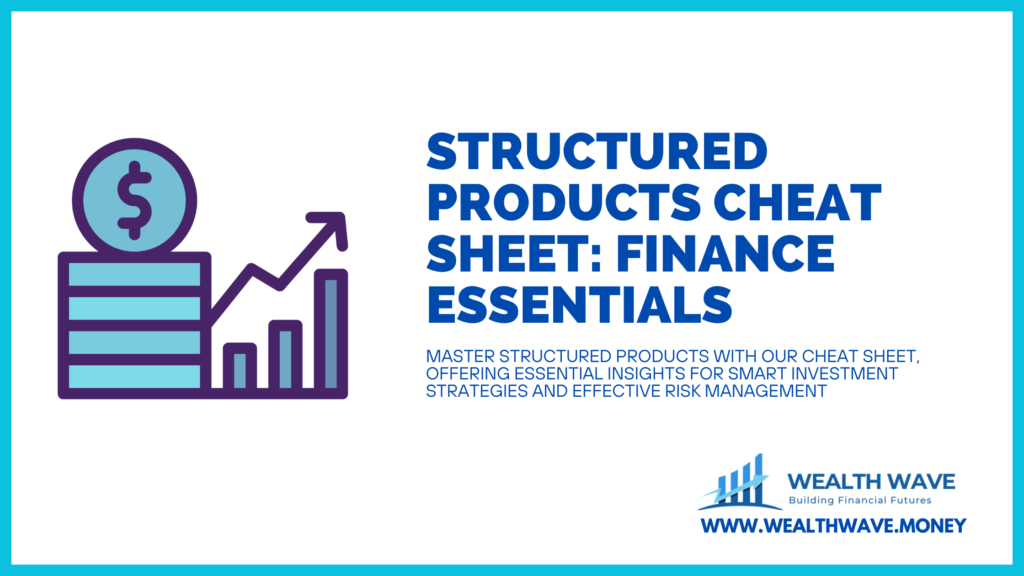Exploring the investment field might often feel like you’re lost in a thick labyrinth. Many of us have been on this journey, searching for the ideal path to enhance our savings, only to encounter a vast array of options at every corner.
This journey to find the right investments that fuel our financial goals while minimizing exposure to unnecessary risk is a common experience.
We sympathetically recognize this challenge as we’ve gone through it ourselves. Interestingly, structured products initially emerged as a solution for investors who felt the traditional fixed income and equity options were insufficient.
With this understanding and exhaustive research, we constructed what we happily refer to as our “Structured Products Cheat Sheet.” Our objective is simple: interpret complex terms and assist you in making knowledgeable decisions about integrating these advanced tools into your investment portfolio.
Continue reading for the clarity you’ve been seeking.
Structured Products Cheat Sheet (Key Takeaways)
• Structured products combine different investments like stocks and derivatives to create custom financial tools. They can protect your money, help it grow, or do a mix of both.
• These investments come in many types, including ones that keep your initial investment safe and others that link your earnings to market performances. This makes them adaptable for different goals.
• Before jumping into structured products, think about the risks like how complex they are and if you can sell them easily. Making smart choices means looking closely at these details.
• To figure out the value of structured products, you need to understand some key ideas like how quickly people pay off their loans in mortgage-backed securities.
• Dr. Jane Harper advises being careful with structured products and using them as part of a bigger plan for managing your money. It’s important to know what you’re getting into before adding them to your portfolio.
What are Structured Products?
Structured products are diverse investment instruments with unique features and risks. They can be customized to meet specific investment objectives and provide ways to improve portfolio returns.
Definition
Structured products are financial instruments created to meet specific needs that cannot be met with standard investment products. They usually combine two or more investment assets, such as securities and derivatives, to provide returns linked to the performance of underlying assets like stocks, bonds, commodities, or market indices.
We use structured products in our portfolios for their ability to offer customized risk-return objectives.
These investment vehicles can vary greatly in terms of complexity and risk level. By leveraging various components, we aim to tailor outcomes related to capital protection, growth, income generation, or a mix of these elements. Moving from the basic principles of barrier notes, we step into the customized structured products. These offer investors a chance to shape their investment tools to meet specific goals.
The structure dictates how payouts occur over the product’s life based on predefined rules tied to the performance of its underlying assets.
Types of Structured Products
Moving from the basics of structured products, we now explore the different types that investors can choose from. There are several categories, each offering unique characteristics and serving diverse investor needs.
One common type is a principal protected note, which promises to return the initial investment at maturity, making it attractive for risk-averse individuals. These notes are ideal for those who seek to safeguard their capital while potentially earning more than traditional savings accounts.
Another popular category includes market-linked investments that tie returns to specific assets like stocks, commodities, or market indexes. Such structured products allow investors to participate in market gains without directly investing in the asset itself.
For example, an equity-linked note’s payout might depend on the performance of a stock index. Investors earn returns based on how well the index does, providing a blend of growth potential and risk management.
This diversity enables us to adapt our portfolio strategies according to changes in financial goals or market conditions.
Origin
Structured products evolved as a method for investors to control risks and pursue profits. They were formed by banks and financial institutions to cater to specific requirements that traditional investment instruments could not fulfill.
These products blend multiple securities, promising the possibility for increased returns and safeguards against losses. This individual combination is suitable for a variety of investment strategies, from risk-averse to bold.
The origin of these products dates back to the 1980s when financial markets began to embrace intricate instruments. The introduction of advanced option trading and fixed-income investments spurred their expansion.
Today, they are integral to portfolio management, hedging, and structured financial solutions in the international market. Following this, we will explore a more in-depth understanding of structured products.
Understanding Structured Products
Structured products offer unique return opportunities and customizable sizing, such as rainbow notes. Consider the associated risks and returns involved before investing further.
Returns
Structured products provide diverse returns, including fixed income, equity-linked returns, or a combination of both. These returns are customized to meet particular investment goals and might rely on intricate structures such as option pricing models and yield curves.
Grasping the mechanisms behind these return profiles is vital for assessing their appropriateness within an investment portfolio.
Assessing the value of structured products necessitates thoughtful consideration of prepayment speeds when working with mortgage-backed securities, and involves modeling using fundamental terms and concepts related to financial derivatives.
This comprehension supports efficient risk management in retail portfolios and asset allocation strategies, guaranteeing well-informed decisions aimed at achieving optimal portfolio performance.
Custom Sizing
Moving from the discussion about returns to custom sizing, it’s essential to understand that structured products offer customization based on individual investor needs and preferences.
Personalizing the sizing allows investors to adjust their investments according to specific terms, such as maturity date, risk tolerance, and return expectations. This flexibility enables retail portfolios to be more aligned with investment strategies and asset allocation goals.
In essence, personalizing the sizing provides an opportunity for investors to design investment products that match their unique financial objectives.
Incorporating personalization into structured products is crucial in meeting diverse investor requirements while providing a well-suited investment strategy. Factors such as customized maturities and risk profiles contribute significantly towards aligning these investments with individual portfolio management approaches, thus enhancing the functionality and appeal of structured products within the ever-evolving realm of investment opportunities.
Rainbow Notes
Rainbow notes, a type of structured product, offer multiple fixed-income securities with varying maturity dates and interest rates. These notes provide diversification within a single investment, reducing risk while offering the potential for higher returns compared to traditional fixed-income products.
Investors can benefit from the flexibility of rainbow notes in tailoring their portfolio’s risk and return characteristics according to their specific investment objectives. Understanding these features is crucial when considering incorporating them into an investment strategy.
Investors should carefully evaluate the underlying assets of rainbow notes as they can be complex and carry different levels of risk exposure. Due diligence is essential in comprehending how each component may perform under various market conditions, ensuring that it aligns with the investor’s overall investment goals and risk tolerance level.
When seeking diversification and customization within a fixed income portfolio, rainbow notes present an opportunity to achieve this through their unique structure.
Risk and Considerations
Transitioning from understanding structured products to considering their risks and considerations is essential for making informed investment decisions. When it comes to risk, we must recognize that structured products may involve a higher level of complexity and risk compared to traditional investments.
It’s crucial to highlight that these investments can be influenced by various factors such as market volatility, interest rate fluctuations, and credit risks. Moreover, investors should carefully consider the potential lack of liquidity of some structured products, which may impact their ability to sell or exit positions quickly if needed.
Before investing in these instruments, conducting thorough due diligence and seeking advice from knowledgeable professionals is recommended.
Benefits and Risks of Structured Products
Structured products offer potential for enhanced returns and portfolio diversification, but they also carry illiquidity risks and complex structuring. Understanding the intricacies in valuing structured products is vital before delving further into investment strategies.
Liquidity
The trading of structured products can differ widely based on their specific design and underlying assets. Some structured products may have restricted trading, meaning that it could be challenging to sell them before maturity.
It’s crucial to carefully consider the potential impact of this lack of immediate tradability on your portfolio, especially if you may need access to these funds in the short term.
Understanding the tradability of a particular structured product is crucial for making informed investment decisions and managing overall portfolio risk effectively.
The tradability of structured products depends heavily on market demand and trading activity, so investors should carefully evaluate potential exit strategies when considering investing in these instruments.
Additionally, the level of intricacy within some structured products can further affect their tradability in certain market conditions, influencing their overall tradability significantly.
Other Risks Associated
When considering structured products, it’s important to be aware of other risks associated. Along with liquidity risk, there is also credit risk and market risk to consider. Credit risk arises from the issuer’s ability to meet its obligations, while market risk refers to the potential impact of market fluctuations on the product’s value.
These risks should be carefully evaluated before investing in structured products.
Investors should keep in mind that structured products are not without their own set of risks. It’s essential for investors to be well-informed about these potential downsides!
Considerations Before Investing
Before investing in structured products, understanding the risks and potential drawbacks is crucial. It’s essential to carefully evaluate the liquidity of the investment, along with its associated risks.
We should also consider factors like market conditions, credit quality, and our risk tolerance levels. Conducting thorough research on the product term sheet and marketing materials will provide valuable insights into how these products work.
Furthermore, seeking professional advice from an experienced investment broker can offer tailored guidance for adding structured products to retail portfolios. Finally, it’s wise to thoroughly review all characteristics and features before making any investment decisions.
Valuing Structured Products
Valuing structured products involves assessing key terms and concepts, as well as modeling prepayment speeds when valuing mortgage-backed securities.
Key Terms and Concepts
Structured products encompass a wide range of investment instruments that combine various financial elements, such as equities and fixed-income securities. These instruments are specifically crafted to meet the needs of individual investors with customized risk-return profiles.
Key concepts include prepayment speeds, determining how quickly principal is repaid on a loan or bond; and mortgage-backed securities, where cash flows from underlying mortgages are packaged into tradable instruments.
Understanding these terms is crucial for accurately valuing structured products.
Valuing structured products involves assessing their risk characteristics and potential returns using models that integrate prepayment speeds and other relevant factors. This process enables investors to make informed decisions about incorporating structured products into their investment portfolios while effectively managing associated risks.
Modeling prepayment speeds
When valuing mortgage-backed securities, it is crucial to consider the modeling of prepayment speeds. Prepayment speed refers to how quickly borrowers pay off their mortgages. This impacts the cash flow to investors holding these securities and needs to be factored into the valuation process.
By evaluating historical data, economic factors, and borrower behavior, we can develop models that help anticipate prepayment speeds and make informed investment decisions.
Moving forward to “Valuing mortgage-backed securities,” let’s explore the key terms and concepts essential for understanding this aspect of structured products.
Valuing mortgage-backed securities
When valuing mortgage-backed securities, it’s essential to consider key terms and concepts. Understanding prepayment speeds is crucial for modeling the valuation of these securities.
Mortgage-backed securities refer to fixed-income investments that are backed by a pool of mortgages and their cash flows. The valuation process involves estimating future cash flows and discounting them back to present value using appropriate interest rates.
Valuing mortgage-backed securities is a critical aspect of structured product investment. Modeling prepayment speeds allows investors to gauge the expected duration and risk associated with these securities accurately.
This understanding forms the basis for making informed decisions about including mortgage-backed securities in retail portfolios or customized investment products offered by brokers.
Conclusion
We examine structured products, untangling their intricate details to enable informed decisions. Dr. Jane Harper, our specialist with over two decades of finance and investment strategy experience, steers the course.
She has a PhD in Financial Mathematics and possesses an exceptional history of aiding firms in managing risk.
Dr. Harper explains that structured products merge securities providing personalized returns associated with underlying assets. These systems are effective for diversifying portfolios and managing risks due to their specific investor-oriented nature.
On the topics of safety and ethics, she emphasizes the importance of transparency. Products must adhere to financial regulations, thus ensuring investors receive detailed information about potential risks and rewards.
For regular use, Dr. Harper recommends cautiously utilizing structured products within a strategic investment plan. These products can function as instruments for hedging or capital protection but necessitate comprehension of terms such as prepayment speeds for mortgage-backed securities.
In assessing benefits and downsides, she points out that although these products offer potential for higher returns and personalization options, they also carry liquidity risks and complexity, which might not be suitable for all investors.
Lastly, Dr. Harper suggests that structured products can be valuable for those who comprehend their nuances—making them beneficial introductions to diversified portfolios for experienced investors exploring options beyond traditional stocks and bonds.
FAQs
Q1. What is a structured products cheat sheet?
Ans. A structured products cheat sheet provides a concise and organized reference for understanding and navigating the complexities of structured financial products.
Q2. How can I use a structured products cheat sheet effectively?
Ans. To make the most of it, familiarize yourself with key terms, understand risk factors, and utilize it as a quick guide for evaluating different types of structured products.
Q3. Are there specific features or components that should be included in a structured products cheat sheet?
Ans. Yes, an effective cheat sheet should include information on product types, payoff structures, underlying assets, risks involved, and potential returns to help investors make informed decisions
Q4. Can a structured products cheat sheet benefit both beginners and experienced investors?
Ans. Absolutely! It serves as an invaluable tool for beginners looking to grasp the fundamentals while also providing seasoned investors with quick access to essential details when making investment decisions.




